|
Melanie and I visited the Udvar-Hazy annex
of the Smithsonian Air & Space Museum for the first time. We visited the main
building in Washington, D.C., a time or two a couple decades ago. A major renovation
of that facility is underway now, but with the rewriting of history going on these
days, their claim of "reimagining"
the displays is worrisome. It is amazing to me when looking at the airplanes represented
in this story from the November 1969 American Aircraft Modeler that most
of them have been restored by now and are on display in one location or the other.
The
Eastern Airlines DC−3 in the first photo has been hanging prominently in the
main Air and Space Museum gallery since the mid 1970s. It appears maybe the authors'
pleas were heeded after all. If I ever have the time, I'll visit the museum and
post pictures of the restored versions along with those provided in the article.
The Silver Hill Story
Will Congress Act in Time?
By Frank and Nancy Pierce
With a handful of dedicated experts and a tiny budget the Smithsonian wages a
desperate struggle to save many of aviation's treasured historic aircraft.
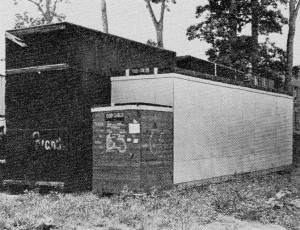
Lack of hangar space makes necessary a temporary use of storage
crates to protect some specimens from the elements. Large crate in this photo houses
a disassembled Japanese bomber from WW II. The Museum hopes to erect additional
hangar space but funding is slow-coming.

Discouraging junk heap actually is collection of parts for two
distinct aircraft, awaiting classification. The original parts are used whenever
possible. Value to researchers is paramount. Motto is preserve rather than restore,
restore rather than replace.
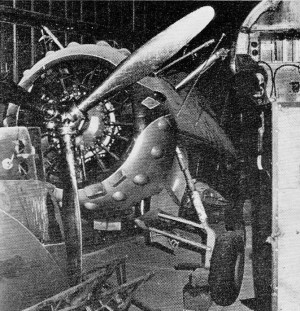
Al Williams' Gulfhawk II now looks like new, will shortly be
loaned by Smithsonian for exhibit at Experimental Aircraft Association's Museum.
Other museums who meet requirements will be similarly honored, in preference to
keeping famous airplanes in dead-storage.
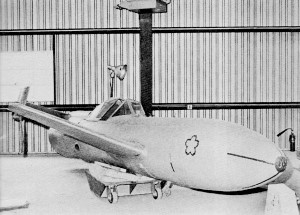
War trophy Japanese Kamakazee "Baka" is complete except for Jap
copy of German Walther rocket engine. External lock on cockpit made ditching this
flying bomb impossible. Flower pattern was frequently used badge by suicide pilots.
Baka means stupid.
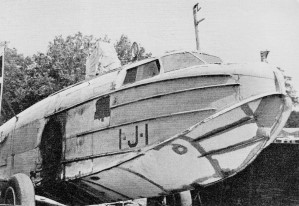
Sikorsky S43 (JRS-1) used by Navy was military follow-on to famous
transpacific airplanes in prewar period. Wings are missing. If funds were available
Museum believes it could fabricate·copies of original wings - if they cannot be
found in the meantime.
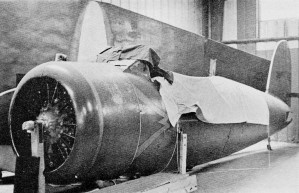
Amelia. Earhart's "Red Bus" - nickname of her Vega - is oldest
Lockheed aircraft in existence. Ship actually consists of parts from two airplanes
due to crackups, and originally was on display by Franklin Institute. Museum also
has Post's Winnie Mae.
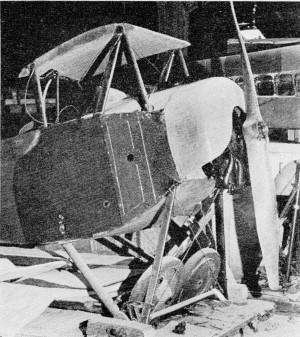
Nieuport 15, once exhibited at now-vanished Roosevelt Field.
Many companion items were lost because of lack of post-WW II storage space.

French Voison, one of group of aircraft received in 1919, is
considered restorable. Needed is a 280·hp Renault engine with 12 cylinders. A Peurot
engine is a legitimate substitute but would require new hardware, which would detract
from the desired authenticity, considered so important.

Caudron G4, acquired in 1919, was sent to the U. S. for an engine
and structural evaluation in 1918. The missing LeRhone rotary engines were replaced
from spare-parts stock. Interesting French plane was on exhibit for years, but removed
to make room for another exhibit.
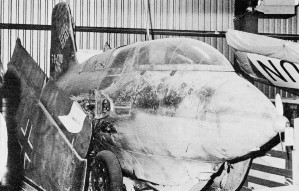
A prize from WW II is this Messerschmitt ME163 rocket-powered
interceptor. It was extensively tested at Edwards AFB after the war. One of the
most dangerous aircraft ever built, the Komet often exploded on mild bounce-landing,
or on over-running field, after touchy glide to earth.
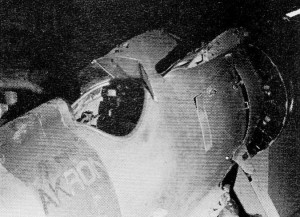
Curtiss F9CZ Sparrowhawk from dirigible Akron provided fighter
escort. It was lowered on trapeze-like rack, which it engaged on return to mother-ship.
This sample is the last survivor of small fleet. "Hook" extended above top wing,
which gulled nicely into fuselage. A great modeling favorite.
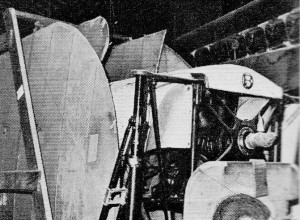
This Bleriot from Roosevelt Field collection was of many built
before WW II in both France and America. It is similar to English Channel-crossing
Bleriot. Note the characteristic "B" on the top cowling. Judging by this photo,
ship is in fair shape.
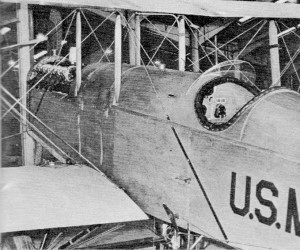
DeHavilland DR4 is one of the few reproductions at Silver Hill.
It was constructed from parts of DH which crashed 1922 in the Rockies. Pilot helped
find wreck 45 years later. Rebuilt plane flew Coast to Coast in 1968 to commemorate
U. S. Airmail Service 50th Anniversary.
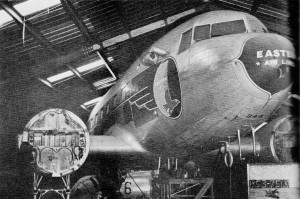
First 1,000,00-miler, an aged DC-3 from Eastern Airlines, now
stripped of wings and engines, was ordered completely refurbished by Eastern in
1953! Eventually, it should be a wonderful exhibit when new museum building finally
becomes reality. Meanwhile, years pass.

Fokker DVII will be returned to factory-new condition. Yards
of silk- screened fabric in the original lozenge camouflage were contracted for,
rather than resort to authentic hand-painting, Museum frequently prefers a restoration
to weathered operational condition.
For those who hold a deep-seated affection for the glory and excitement of aviation
history, there is perhaps no place on earth quite like the National Air and Space
Museum's Preservation and Restoration Facility in Silver Hill, Maryland. Few people
know of its existence. There are enough sights and smells and memories of historic
aircraft at Silver Hill to relive in one day the entire chronology of flight.
Housed in and around a group of metal hangars, the Smithsonian Institution has
gathered a collection of some of the world's most important aircraft. The Silver
Hill collection lies fenced off from the world, a sort of aircraft limbo until the
final authorization for the new National Air and Space Museum building becomes a
reality. When? Perhaps next year, the following year, .maybe ten years. No one can
say.
Don't mark Silver Hill on your itinerary for your trip to Washington. Surrounded
by fencing, its gates are permanently closed to the public. No one enters unless
he has specific permission from a senior Museum official. Once in, a guard escort
is assigned to you. Freedom of movement is as carefully controlled as it is on a
U. S. nuclear weapons station. These precautions are essential. The Smithsonian
is the custodian of an aircraft collection of such size and significance that it
cannot be evaluated in cash values.
Through the dedication of a small staff and the stretching of a very small budget,
the Silver Hill Facility has managed to preserve in a state of suspended animation
nearly 200 aircraft, and find enough money left over to restore some items in the
collection.
With few exceptions, most of the aircraft are preserved but not restored. "We
are holding our own, at least for the time," one official told me. Their primary
task is to keep time from taking further toll. Older, fabric-covered aircraft are
stored partially disassembled in large dry hangar-like sheds. More recent and more
rugged aircraft must be left outside, protected only by shards of plastic cocoons
over more vital areas. As fast as funds and personnel become available, new hangars
are constructed, or large packing crates are built to partially protect the aircraft
from the weather.
Our escort opened the padlocked door of the largest hangar. Saturated by a ghostly
green light filtering down from the few plastic skylights, stood a double row of
aircraft, stripped of wings, and covered by the accumulated dust of years. The sensation
was that of meeting an old friend after many, many years. I recognized them immediately,
but could not help being struck by what the years had done. The fact that they were
older didn't decrease the pleasure at all.
The clean, sleek beauty of a Northrop Gamma comes through, even with its wings
removed. A familiar curve of a fuselage, the recognizable lines of cockpit and wind-screen,
a characteristic rudder which you have known since you were a boy. Though covered
by a plastic sheet, how could anyone fail to recognize the massive, but somehow
arrogant fuselage float of Grover Loening's famous amphibian of the twenties.
A SPAD XIII occupies one corner, sans tires and wings, but endowed with a magical
grace and beauty which years can't take away. I remember this SPAD when, as a youngster,
I used to visit the Museum during World War II, and World War I seemed even farther
removed than it does today.
The SPAD was flown by a young AEF officer, when it was returned to the States
to spearhead a Liberty Bond drive. When he saw the old SPAD on display, he caused
consternation among the guards at the old aviation building, when he crossed the
railing and climbed into the cockpit! Then he signed autographs, to the delight
of visitors.
A German ME 262, stripped of its wings and jet engines like a dead gray shark,
just as it had been shipped from Europe. Scratched, dirty, the black Balkancruz
insignia peeling and flaking from its fuselage, it was one of WW II's secret weapons.
The dirt on the cockpit floor, bits of trash and litter, left there by some unknown
Luftwaffe pilot. When the Smithsonian restores this aircraft, something will be
lost in the process - that bit of litter.
In another building, almost hidden behind a fully assembled Grumman F6F, was
an aircraft which I had known personally. I hadn't expected to see it in the collection
so the feeling of nostalgia and recognition was particularly strong. Suspended awkwardly
atop its single center-mounted float was the fuselage of one of the N3N-3 "Yellow
Peril" trainers from the NAF training squadron at the Naval Academy.
During the Korean War, I was stationed at the Air Facility across the Severn
River from the Academy. Even then we took a certain pride in manning the last operational
squadron of biplanes anywhere in the world (a dubious claim, but we believed it).
Here was number 44 from the original group of 48, old, crippled, but a plane which
I had fueled, hosed down, trundled from the hangar for morning flights, and waded
waist-deep in the Severn to recover at the end of a day's flying.
I went from one hangar to another, taking photographs where there was room to
focus. Nowhere was there really enough room, because space at Silver Hill is at
a premium. Some aircraft were buried so deeply that photography was impossible.
A DeHavilland Mosquito fuselage for example.
In spite of the crowding, there was order. Fuselages, wings, and component parts,
were all marked with a catalogue number. But there is space around each aircraft.
Nowhere did two aircraft touch in such a way that either would be damaged.
You must know where to look. Somewhere in Hangar 7 are the remains of an Albatros
DV. I was curious to see how the plywood fuselage had withstood storage. But toward
the rear of the hangar was Amelia Earhart's Lockheed Vega.
This was a premium aircraft! The quality of construction still shows through
the dust - in the fit of the plywood skin and smoothness of the paint, the beautifully
constructed fillets. Lockheed constructed the Vegas, Altairs and Sirius to the custom
of each purchaser. The Earhart Vega still wears the Lockheed crest proudly on its
vertical stabilizer.
Silver Hill also maintains aerospace hardware. Some of the Mercury and Gemini
spacecraft are stored there in a hangar similar to those which house the aircraft
collection. These are part of my own time, however. The burned and charred capsules
sitting mutely on wooden pallets couldn't recapture the grandeur of the moment at
Cape Canaveral. Space hardware is designed for an alien environment, not intended
to conquer an ocean of air.
A space capsule is a coldly calculated thing. It is pure function, down to the
last ablated inch of blackened heat shield. None of the intuitive curve, the graceful
sweep, conceived mostly by inspiration and a deep-rooted feel for the air. In short,
none of the sheer majestic beauty of the Northrop Gamma, or the light and delicate
grace of the Nieuport Scout which still come through in spite of a half-century
of decay. The capsules speak more of what is yet to be.
Time is truly of the essence. As years pass, in spite of the efforts of the people
at the Air Museum, all of this will gradually diminish. Fabric rots, metal corrodes,
records are lost, last survivors disappear and the type is extinct. The aircraft
which could be preserved this year will require complete restoration next year,
and ten years hence will require extensive re-fabrication of many parts. Then it
is, to some extent, a copy and its worth to aviation research is reduced by that
much.
Congressional action could prevent this.
Funding for the construction of the new National Air and Space Museum building
in Washington would provide a long-needed center for aviation research and a show-place
worthy of this magnificent collection. But Congress must appropriate the funds.
The Silver Hill-collection should be given back to the people.
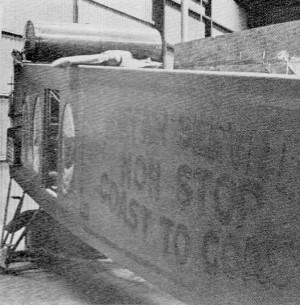
First aircraft to fly non-stop coast-to-coast (East to West at
that!) was Fokker T2. It is now fully restored. Thanks to Fokker's design genius
it still holds record for greatest weight per horsepower. Engine was wartime Liberty
of 423 hp. On record flight groundspeed was 92 mph.
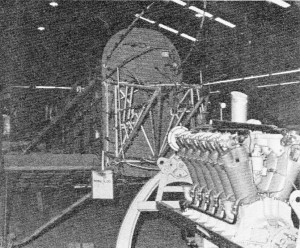
Now undergoing complete restoration is Douglas DTZ World Cruiser
"Chicago," flagship of round-the--world flight in 1924. Liberty V12 engine will
be sent to Iceland this year for 25 Independence Anniversary. Plane stopped there
on flight. Restoration and display will follow.
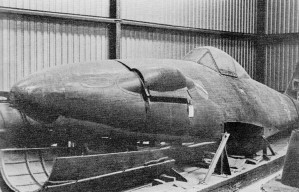
Messerschmitt ME262 twin-jet-powered recon served during last
days of WW II with Jadgeschwader 7. It was one of 11 captured at end of war. Serial
number and name plate were removed by a souvenir hunter after plane was shipped
to this country, making identification and history difficult to track down.
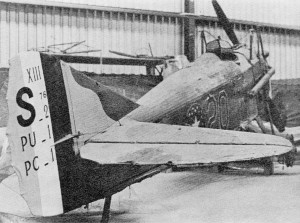
SPAD XIII scheduled for restoration to service condition, as
it was at end of war, preserving bullet holes and sears. Ship was sent here for
incentive in Liberty Bond drive. Original fabric will be backed by new technique.
Museum was to acquire Rickenbacker's SPAD but aircraft was destroyed by fire while
on exhibit in Illinois, a sad loss.

Gull-winged F4U Vought Corsair of Pacific Theater fame in WW
II is typical of complete series of naval aircraft donated by Navy at war's end.
Unfortunately. from Museum's viewpoint, log books were destroyed and individual
histories lost. Nevertheless, these are historic aircraft meeting Museum criteria.

Lincoln Ellsworth's trans-Antarctic Northrop Gamma is in excellent
shape. Ellsworth was reluctant to donate aircraft, thinking he would use it again.
Museum agreed to store craft, even keeping battery charged. Plane will be preserved,
not restored. Rough-landing wrinkle in fuselage will remain as was.
Posted October 28, 2021
(updated from original post on 8/8/2012)
|